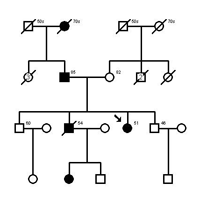

Visionary
Bringing Genetics into Focus for Patients
By Susan E. Johnson
NEI Science Writer

Delphine Blain, M.S., M.B.A., (right) a certified genetic counselor in the NEI Ophthalmic Genetics and Visual Function Branch, discusses a genetic diagnosis with a patient.
Delphine Blain, M.S., M.B.A., had a life-changing moment in 1999. It occurred while she listened to a genetic counselor tell career stories at a Smithsonian Institution conference in Washington, D.C. At the time, Blain was dissatisfied with her job as a health management consultant, so the thought of chasing her lifelong interest in science resurfaced. As a result, she pursued a master's degree in genetic counseling, which she completed in 2004. Since then, Blain has worked as one of two genetic counselors in the National Eye Institute (NEI) clinic.
In a recent interview, Blain discusses the challenges and satisfactions of helping patients and their families understand the science of genetic conditions and cope with a genetic diagnosis.
Why might patients see a doctor in the genetics branch of the NEI clinic?
Most patients come to us for one of two reasons: to receive a diagnosis for an eye condition, or to learn more about an already diagnosed genetic eye condition and potentially participate in a future clinical study. Sometimes people are referred by their doctor, and other times they call us on their own after finding us through word-of-mouth referrals or Internet searches.
What is genetic testing, and can patients get genetic testing done at the NEI?
A genetic test is not available yet for all hereditary eye conditions. When it is available, genetic testing is done by taking a blood sample and looking for specific changes, or mutations, in the gene or genes that scientists have identified as associated with a particular eye condition. For example, one of the most common disorders we see is retinitis pigmentosa (RP). This actually refers to a group of diseases with similar symptoms. Patients have difficulty seeing at night first, and their peripheral vision is lost over time. Their eye care professional may also notice changes in the retina in the back of the eye. RP can be caused by mutations in many different genes. We are able to do some testing for RP, but these tests may not show a mutation in the genes tested because not all of the genes for RP have been identified, and some changes are difficult to interpret.

This simplified pedigree chart shows four generations of a family with a genetic eye condition. Squares represent males and circles represent females. Darkened shapes represent people who have been diagnosed with the disease.
How does your counseling relationship with patients begin?
Usually I call them before their appointment at the NEI to gather the family information and medical history that I need to draw their pedigree, and to help identify any additional testing that may need to be scheduled. A pedigree is a family tree that contains medical information. It helps us figure out how a disease is passed between generations, which then can give us hints about what gene or genes might be involved. I also try to understand why people want to come to the NEI, identify their questions, and determine what they hope to gain from the visit.
What are patients' typical concerns before their appointment?
A lot of times, patients will say to me: "I want to know for certain what disease I have," and "I'm looking for a treatment." That's when I have to tell them that doctors will do their best, but it can sometimes take more than one visit to come up with a diagnosis when patients have very rare conditions with complex symptoms that develop over time. If genetic testing is offered, it can take months before results become available. And, right now, we can't offer any cures for hereditary eye conditions. But we can talk to patients about research that's going on in the field.
When do you interact with patients during their appointment at the NEI?
If a doctor decides to run a genetic test, I discuss the details of the test with the person being tested. Before any testing is done, a person must sign an informed consent document. This can only be signed after he or she fully understands the testing process and agrees to undergo testing. I may also meet with patients and their families to explain the genetic condition, evaluate how they are coping with the diagnosis, and provide them with resources, such as the names of support groups.
"[Part of my job] involves listening to patients' stories, validating their feelings, talking about family dynamics, and discussing how they cope on a day-to-day basis," Blain says.How do you explain genetics to people who may not have any science background?
First, I always ask them how much they want to know. I never assume that people will want to delve into a lot of details. But for the most part, people say they want to understand their condition as much as possible. So I go back to the basics--What are genes? What are proteins? What is a mutation? What is a genetic disease?
What's the most satisfying part of your job as a genetic counselor?
My satisfaction comes from helping patients. It may involve listening to patients' stories, validating their feelings, talking about family dynamics, or discussing how they cope on a day-to-day basis. Information can also have a huge impact on patients. Sometimes people say they were told that there is nothing anyone can do about their condition. Here at the NEI we know that new clinical trials are always being planned, and new discoveries are being made. Maybe there's nothing we can do about it now, but there is hope.

